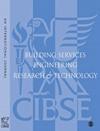测量灰泥调节室内湿度潜力的方法的发展
IF 1.8
4区 工程技术
Q3 CONSTRUCTION & BUILDING TECHNOLOGY
Building Services Engineering Research & Technology
Pub Date : 2021-06-14
DOI:10.1177/01436244211025431
引用次数: 1
摘要
湿气缓冲利用吸湿建筑材料作为一种更可持续的方法,被动地调节室内湿度。本研究旨在开发一种可重复的测试方法,以在反映典型室内环境条件的条件下获得普通建筑材料的水分缓冲值。研究了两种不同材料(通常用于内表面抛光)正弦曲线中的温度和湿度变化,以确定其潜在的湿度调节行为。然后将结果进行组合和排序,表明材料被动调节室内湿度的潜力以及对稳健调查方法的需求。实际应用:根据当前的实践和材料的测试程序,考虑采用一种可重复的测试方法,以全面了解吸湿材料的性能,从而对其性能的后续解释进行量化。考虑使用吸湿材料进行被动调节的实用性可以证明,在不严重依赖机械解决方案的情况下,使室内相对湿度接近最佳范围,从而实现更有效的被动室内气候监测。预计这项研究的结果可能会成为进一步改进标准化测试方法的基础,以获得吸湿性非结构元件的水分缓冲值,用于设计集成过程中的实际应用。本文章由计算机程序翻译,如有差异,请以英文原文为准。
Development of methods to measure the potential of a plaster to regulate indoor humidity
Moisture buffering utilises hygroscopic construction materials as a more sustainable approach to passively moderate indoor humidity. This study seeks to develop a reproducible test method to obtain a moisture buffering value of common building materials under conditions that reflect typical indoor environmental conditions. Temperature and humidity variations in sinusoidal profiles for two different materials, typically used to finish internal surfaces, have been studied to identify their potential moisture regulation behaviour. Outcomes were then combined and ranked indicating the potential of materials to passively regulate the indoor humidity and the need for robust methods of investigation. Practical application: In response to current practice and materials’ testing procedures, a reproducible test method is considered to enable comprehensive understanding of a hydroscopic materials’ behaviour, where subsequent interpretation of their performance can be quantified. The practicality to consider the use of passive regulation using hygroscopic materials can then be justified to bring indoor RH closer to the optimal range without heavy reliance on mechanical solutions, achieving a more effective passive indoor climate monitoring. It is expected that the outcome of this investigation can potentially form the basis of further improvement on a standardised test method to obtain moisture buffering value of hygroscopic non-structural elements for pragmatic application during design integration process.
求助全文
通过发布文献求助,成功后即可免费获取论文全文。
去求助
来源期刊

Building Services Engineering Research & Technology
工程技术-结构与建筑技术
CiteScore
4.30
自引率
5.90%
发文量
38
审稿时长
>12 weeks
期刊介绍:
Building Services Engineering Research & Technology is one of the foremost, international peer reviewed journals that publishes the highest quality original research relevant to today’s Built Environment. Published in conjunction with CIBSE, this impressive journal reports on the latest research providing you with an invaluable guide to recent developments in the field.
 求助内容:
求助内容: 应助结果提醒方式:
应助结果提醒方式:


